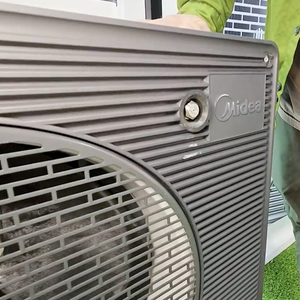I have a house heated with electric baseboard heat. We have eight heating circutes in the living areas, basically each room’s heaters are on a seperate 240 volt, 20 amp circut, each contolled by a line voltage thermostat. (except for the family room, which is a 30 amp circut controlled by a low voltage term. operating a solanoid switch.) Over the years I’ve noticed the wide temperature swings caused by the line voltage jobs. These have been in service for 30 years, and after my latest addition and room reconfigurations, where new thermostats were installed, they seem to be more inacurate than the old ones. The rooms get really cold before coming on and go much higher than set temp before going off.
I’ve recently become aware of a line voltage thermostat that fiunctions with a microchip (Aube Technologies TH101) that is touted to be very accurate. Plus it is proportional, meaning it applies only the voltage needed to maintain the set temperature, either 25, 50, 75 or 100%. I’ve been thinking of trying three of these on the first floor to see how they work, they are not cheap, about $75.00 each, then replacing floor two if they turn out to be worth it. Their big claim is that because they are so accurate and the temperature doesn’t swing so wide, you can set them lower, be just as comfortable and save money.
I have two questions I need some help with. First, has anyone heard about these, and are they reliable, or do they have some hidden pitfalls? Second, I have one circut, in the livingroom I’m not sure they can handle. It now has three eight foot heaters rated at 1500 watts each @ 240 volts, which works out to 4500 watts total and 18.75 amps. This has operated flawlessly for 30 years, except for the inaccuracy part, on a 20amp circuit. The Aube thermostat has a load rating of 4000 watts @ 240 volts and a resistance load of 16.5 amps. The sales guy at my supplier says I’m still ok because I’m probably not really getting a full 240 volts, but I’m not sure. Do you think I’ve got a problem with this circuit? I don’t want to blowup a $75 dollar thermostat to find out. Any help or advice would be GREATLY appreciated. Thanks’
“Old Mr. Lucky“
Edited 2/1/2005 11:47 am ET by lucky
Edited 2/1/2005 12:22 pm ET by lucky
Edited 2/1/2005 3:40 pm ET by lucky



















Replies
Please post with the default font and size.
Your message is unreadable on my screen.
A Thermostat is like a switch..It will switch an appliance on/off according to the setting.But the problem can be WHERE they are located. Are these in question at the floor level built into the heater.? The ones at floor level are not very accurate in sensing the actual overall room temp.
Independent T stats for electric baseboard heating are best mounted separately on the wall far enough away from the heater so as to not be influenced by any 'direct' heat. Also they are best if mounted at 4'-5' above floor level.
These T stats are line voltage and sell for approx 12.$ each. There is no need for any other 'special' type.
Sorry, I thought I had all the questions covered. These are all wall mounted, about 58" from the floor. The old ones are Federal pacific, the two new ones don't seem to have a name and are quite inaccurate. the one in the kitchen needs to set at a little under 60 to hit a temperature range of around 65-70.
Your "Family" room tstat is a 24V low voltage type, used to control a dual circuit relay for heat loads over 3840 Watts ( Max Heat circuit 20A x 240V = 4800W x 80% = 3840W / 250W per ft = 15' of electric baseboard heat per circuit) you cannot use a line volt tstat. I would try the Honeywell Dual-Diaphragm Electric Heat Tstat # T4398A1021 (Graingers.com) its a decent Tstat for around $12-$15
Edited 2/1/2005 5:10 pm ET by BigMan
I'm sorry to disagree on this point, but my living room really is on a 20 amp, 240 breaker, the family room does have a low voltage control like you discribe. In the living room there is the same single pole, line voltage Federal Pacific thermostat as all the other original installations. And I am familiar enough with the main box to know which circuit it is. The circuit consists of three FP 8' heaters. Their plates say they are rated at 1500 watts-240 volts or 2000 watts-270 volts each. Somehow this works in the present set-up. My concern would be any new device that is more than a simple bimetal switch like what is there now, that is something with a "thermistor" or other solid state circuitry, would not be rated for this high wattage.
Do you think it would be beneficial to "blow-out" these old thermostats with some canned air, like the kind they sell for computer or electronics? My thought is maybe the accumulation of airborne dirt over the years is making them even more inaccurate.
I think the ultimate answer is to move from the miserably cold northeastern Ohio weather to a warmer climate, but I've waited too long. Learn from my mistake, and relocate before grandchildren or else your wife will never allow it!
Edited 2/1/2005 2:11 pm ET by lucky
I did not try to read your orginal message so I don't know the details.But there are solid state devices (electronic) that can control 100's of amps and at voltages much higher than 240.I would not be concerned with one from a good brand such as Honeywellhttp://content.honeywell.com/yourhome/ptc-thermostats/Therm_Choose.htm
Yep thats the Tstat we have had good luck with in the past, no callbacks or complaints!!
except for the family room, which is a 30 amp circut controlled by a low voltage term. operating a solanoid switch.)
Sorry I meant your family room. The older tstats used a bimetallic strip and had an allen set screw for adjustment. I dont know if blowing dust off will help, but for a lousy $12 I would buy 1 Honeywell Dual-DiaphragmThermostat and try it in one room before I bought a bunch of $75 tstats, you might be suprised!!
I checked out the Honeywell T4398 on the link and it sounds like it will fill the bill. I like the fact that it only varies 2 degrees. There is even a Grainger retail outlet close by and I get an extra 10-off because of my farm bureau membership. I guess sometimes it pays top live in the sticks. I'm going to give it a try! Thanks for the advice.
I can't read it either...
proud member of the FOR/FOS club...
Life is not a journey to the grave with the intention of arriving safely in a pretty and well preserved body, but rather to skid in broadside, thoroughly used up, totally worn out, and loudly proclaiming
WOW!!! What a Ride!